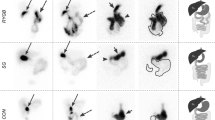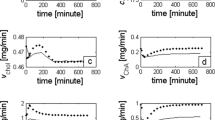Abstract
Gallbladder mucosal absorption of fluid duringfasting is a well-known process. Indirect in vivo andrecent in vitro evidence for physiologically relevantgallbladder absorption of cholesterol and phospholipids from bile has been observed in humans. Thepresent study explored and compared by indirect meansthe relative efficiences of human gallbladder mucosalabsorption of fluid and lipids in health and disease. Biliary lipids and pigment content weremeasured in fasting gallbladder bile samples obtainedfrom gallstone-free controls and from four study groups:multiple and solitary cholesterol gallstone patients, and morbidly obese subjects with and withoutgallstones. Bile salts and pigment content weresignificantly greater in gallstone-free controls than inall other disease study groups. This was interpreted as evidence of more effective gallbladdermucosal fluid absorption in nonobese gallstone-freecontrols compared to that in all other groups.Correlation plot analyses of biliary lipids showed lowerconcentrations of phospholipids than expected from the indexbile salt concentrations. The same was found forcholesterol concentrations but only in supersaturatedsamples. These findings were much more pronounced in gallstone free-controls and were accordinglyinterpreted as evidence of more efficient gallbladderabsorption of both phospholipids and cholesterol incontrols compared with that found in each of the disease study groups. Moreover, impaired gallbladdermucosal function, while invariably associated withcholesterol gallstone disease, was not found to be anecessary consequence of the physical presence ofstones. It is concluded that efficient gallbladdermucosal absorption of both fluid and apolar lipids frombile is a normal physiological process that is oftenseriously impaired in the presence of either cholesterol gallstone disease or at least one of itsprecursor forms.
Similar content being viewed by others
REFERENCES
Svanvik J: Role of gallbladder in modifying hepatic bile composition. InHepatic Transport and Bile Secretion Physiology and Pathophysiology. N Tavoloni, PD Berk (eds). New York, Rave n Press, 1994, pp 607- 618
Holan KR, Holzbach RT, Hermann RE, Cooperman AM, Claffey WJ: Nucleation time: A key factor in the pathogenesis of cholesterol gallstone disease. Gastroenterology 77:611- 617, 1979
Sahlin S, Danielsson A, Angelin B, Reihnér E, Henriksson R, Einarsson K: Mucin in gall bladder bile of gall stone patients: Influence of treatme nt with chenodeoxycholic acid and ursodeoxycholic acid. Gut 29:1506 - 1510, 1979
Gallinge r S, Harvey PRC, Petrunka CN, Ilson RG, Strasberg SM: Biliary proteins and the nucleation defect in cholesterol cholelithiasis. Gastroenterology 92:867- 875, 1987
Ostrow JD: Absorption by the gallbladder of bile salts, sulfobromophthale in, and iodipamide. J Lab Clin Med 74:482- 494, 1969
Ostrow JD: Absorption of organic compounds by the injured gallbladder: J Lab Clin Med 78:255- 264, 1971
Svanvik J, Allen B, Pellegrini C, Bernhoft R, Way L: Variations in concentrating function of the gallbladder in the conscious monkey. Gastroenterology 86:919 - 925, 1984
Strasberg SM, Toth JL, Gallinger S, Harvey PRC: High protein and total lipid concentration are associated with reduced meta-stability of bile in an early stage of cholesterol gallstone formation. Gastroenterology 98:739 - 746, 1990
ChijiiwaK, Hirota I, Noshiro H: High vesicular cholesterol and protein in bile are associated with formation of cholesterol but not pigment gallstones. Dig Dis Sci 38:161- 166, 1993
Nakano K, Chijiiwa K: Reduced cholesterol metastability of hepatic bile and its further decline in gallbladder bile in patients with cholesterol gall stones. Gut 34:702- 707, 1993
Ross PE, Butt AN, Gallacher C: Cholesterol absorption by the gallbladder. J Clin Pathol 43:572- 575, 1990
Jacyna MR, Ross PE, Bakar MA, Hopwood D, Bouchier IAD: Characteristics of cholesterol absorption by human gall bladder: Relevance to cholesterolosis. J Clin Pathol 40:524 - 529, 1987
Ulissi A, Purdum PP, Moore EW: Vesicular phospholipid transport in cultured human gallbladder epithelia is dependent on vesicular size, epithelial confluency, and presence of oxygen. Hepatology 18:95A, 1993 (abstract)
Purdum PP III, Shamburek RD, Hylemon PB, Moore EW: Rapid phospholipid (PL) transfer across cultured human gallbladder epithelia. Gastroenterology 102:A871, 1992 (abstract)
Neiderhiser DH, Harmon CK, Roth HP: Absorption of cholesterol by the gallbladder. J Lipid Res 17:117- 124, 1976
Neiderhiser DH, Morningstar WA, Roth HP: Absorption of lecithin and lysolecithin by the gallbladder. J Lab Clin Med 82:891- 897, 1973
Booker ML, Scott TE, LaMorte WW: Effect of dietary cholesterol on phosphatidylcholines and phosphatitylethanolamines in bile and gallbladder mucosa in the prairie dog. Gastroenterology 97:1261- 1267, 1989
Shiffman ML, Sugerman HJ, Moore EW: Human gallbladder mucosal function. Gastroenterology 99:1452- 1459, 1990
Ginanni Corradini S, Della Guardia P, Giovannelli L, Ripani C, Elisei W, Quartini A, Corsi A, Codacci Pisanelli M, Chirletti P, Caronna R, Ziparo V: Biliary cholesterol and phospholipid absorption by the gallbladder mucosa is impaired in cholesterol gallstone disease. A study in the isolated in vitroperfused human gallbladder. Hepatology 24:323A, 1996 (abstract)
Tera H: Stratification of human gallbladder bile in vivo. Acta Chir Scand Suppl 256:1- 85, 1960
Strasberg SM, Robert P, Harvey PRC, Hofmann AF: Bile sampling, processing and analysis in clinical studies. Hepatology 12:176S- 182S, 1990
Turley SD, Dietschy JM: Re-evaluation of the 3α-hydroxysteroid dehydrogenase assay for total bile acids in bile. J Lipid Res 19:924 - 928, 1978
Takayama M, Itoh S, Nagasaki T, Tanimizu I: A new enzymatic me thod for determination of serum choline-containing phospholipids. Clin Chim Acta 79:93- 98, 1977
Gurantz D, Lake r MF, Hofmann AF: Enzymatic measurement of choline-containing phospholipids in bile. J Lipid Re s 22:373- 376, 1981
Allain CC, Poon LS, Chan CS, Richmond W, Fu PC: Enzymatic determination of total serum cholesterol. J Clin Chem 20:470 - 475, 1974
Bloch HM, Thornton JR, Heaton KW: Effects of fasting on the composition of gallbladder bile. Gut 21:1087- 1089, 1980
Neder J, Wasserman W, Kutner MH: Applied Linear Statistical Models, 3rd ed. Homewood, Illinois, Irwin Publishing, 1990
Woolson RF: Statistical Methods for the Analysis of Biomedical Data. New York, John Wiley & Sons, 1987
Everhart JE: Contribution of obesity and weight loss to gallstone disease. Ann Intern Med 119:1029 - 1035, 1993
Ostrow JD: Absorption of bile pigments by the gall bladder. J Clin Invest 46:2035- 2052, 1967
Kesäniemi YA, Miettinen TA: Biliary secretion of bilirubin and lipids in chronic cholestatic liver disease. Scand J Gastroenterol 20:433- 438, 1975
Raedsch R, Stiehl A, Gundert-Remy U, Walker S, Sieg A, Czygan P, Kommerell B: Hepatic secretion of bilirubin and biliary lipids in patients with alcoholic cirrhosis of the liver. Digestion 26:80 - 88, 1983
Harvey PRC, Toth JL, Upadhya GA, Ilson RG, Strasberg SM: Total protein output during rapid reduction of bile salt secretion rates in man. Gut 30:118 - 122, 1989
Bennion LJ, Grundy SM: Effects of obesity and caloric intake on biliary lipid metabolism in man. J Clin Invest 56:996 - 1011, 1975
Carulli N, Loria P, Bertolotti M, Ponz de Leon M, Menozzi D, Medici G, Piccagli I: Effects of acute change s of bile acid pool composition on biliary lipid secretion. J Clin Invest 74:614 - 624, 1984
Alvaro D, Ange lico M, Cantafora A, Di Biase A, De Santis A, Bracci F, Minervini G, Ginanni Corradini S, Attili AF, Capocaccia L: Biliary secretion of phosphatidylcholine and its molecular species in cholecystectomized T-tube patients: Effects of bile acid hydrophilicity. Biochem Med Metab Biol 36:125- 135, 1986
Carey MC, Mazer NA: Biliary lipid secretion in health and in cholesterol gallstone disease. Hepatology 4:31S- 37S, 1984
Hayashi A, Lee SP: Bidirectional transport of cholesterol between gallbladder epithelial cells and mode l bile. Am J Physiol 271:G410 - G414, 1996
Rights and permissions
About this article
Cite this article
Corradini, S.G., Yamashita, G., Nuutinen, H. et al. Human Gallbladder Mucosal Function (Effects on Intraluminal Fluid and Lipid Composition in Health and Disease). Dig Dis Sci 43, 335–343 (1998). https://doi.org/10.1023/A:1018858406560
Issue Date:
DOI: https://doi.org/10.1023/A:1018858406560




